| |
 Vienna is a city brimming with architectural wonders and museums and, while you could easily spend many days there, if you're pressed for time (like we were) there are a number of must-sees within walking distance of the center.
Vienna is a city brimming with architectural wonders and museums and, while you could easily spend many days there, if you're pressed for time (like we were) there are a number of must-sees within walking distance of the center.
We started our tour of Vienna's major attractions, armed with our trusty LP guidebook,
at the main Tourist Office at Karntner Strasse. Karntner Strasse is a wide pedestrian-only avenue lined with expensive boutiques and outdoor cafes. It was fun just to stroll along watching and listening to the numerous, and sometimes talented, street performers.
As we travelled north we took a quick side trip down Donnergasse which led to the beautiful Donner Fountain that dates back to 1739. The four naked figures apparently a little risqué for Maria Theresa's taste) represent the four main tributaries of the Danube, the Enns, March, Traun and Ybbs. Also in the square is the Church of the Capuchin Friars which houses the Imperial Vault. The vault was commissioned by Empress Anna who was the first to be buried there along with her husband Emperor Matthias. Although we didn't go inside, there has apparently been some expert restorations done on a couple of the more elaborate tombs.
A few more blocks north and we came to the Stock im Eisen Platz. Here we found St. Stephen's Cathedral with its magnificent tiled roof and 137m high South Tower (Sudturm). The Cathedral was built in 1359 on the site of a 12th century church from which the main entrance, among other things, remains. Across from St. Stephen's is the modern, silver and glass structure, Haas Haus.
A nice foil for the historic cathedral with which it shares the square. And, after we looked around for a bit, we found the "nail-studded stump" enclosed in glass at the corner of the square to the south of Haas Haus. It is said that , in the 16th century, local blacksmiths used to pound a nail in to the tree, whenever they left the city, for good luck.
We turned left at the "stump" and cruised down Graben for some more window shopping. This up-market street is dominated by the Plague Column, a rather garish and morbid memorial to Vienna's thousands of victims of the Black Death in the late 17th century. Graben also boasts the highly recommended Haagen-Dazs ice cream shop!
At the end of Graben, rather than turning left on to Kohlmarkt (where they used to sell charcoal), we continued in the same direction down Naglergasse. We took a left at Freyung, went past the Court/Church of the Scots, took another left at Teinfaltstrasse, and stopped to look at the striking Burgtheater.
Across the street (Dr. Karl Lueger Ring) from the theater we were fortunate enough to come across a type of "Taste of Nations" going on in Rathauspark. Countries from all over Europe were selling arts and crafts as well as culinary delights and beer (most important of course!). At Rathausplatz we saw the Rathaus, or City Hall, a lovely Gothic creation completed in 1873,which serves as a both City Hall and a popular place for young skateboarders to polish their skills.
A short distance to the south-east of the Rathaus we spent some time gazing up at the more than impressive Parliament building. Built from 1873-1883 and designed by Theophil Hansen its soaring columns provide an excellent backdrop for the stunning Athena Fountain sculpted by Karl Kundmann. Hansen's idea was to use the symbols of democracy and wisdom in the hopes that Austrian politicians would display the same qualities.
We decided to cut through the Volksgarten to get back to Kohlmarkt where we started our little detour. We actually ended up at Michaelerplatz. Unfortunately, St. Michael's Church was under construction and we were unable to view its mish-mash of architectural styles.
We passed through the immense dome of St. Michael's Gateway to find ourselves in Heldenplatz with the curving Neue Hofburg on the left. This structure, built from 1881-1908 was the site of one of Hitler's rallies in 1938 upon his return to Vienna. To our right we could see the eye-catching spire of the Rathaus peeking through the orange and yellow leaves of the trees in the Volksgarten and Rathauspark. We went on straight ahead through the Palace Gates across Burgring to Maria Theresia Platz.
A large statue of Maria Theresa sits flanked by the identical twins, the Museum of Natural History and the Museum of Fine Arts.
Both museums were completed in the late 19th century by the team of Gottfried Semper, who did the exteriors, and Karl von Hasenauer, who did the interiors.
To finish off our walking tour of Vienna we followed Opernring east, past a statue of Mozart in the Burggarten, until we reached the State Opera House (Staatsoper) between Operngasse and Karntner Strasse. It was originally completed in 1869 but was virtually destroyed in WWII and didn't reopen until 1955. It would have been lovely to witness a performance and see the opulent interior but, alas, we had neither the time nor the money.
Next time!
Shona
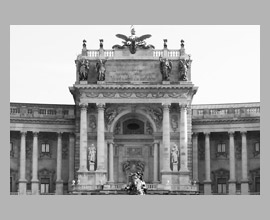  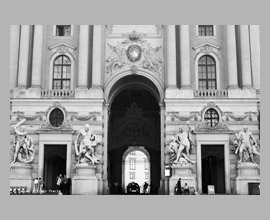  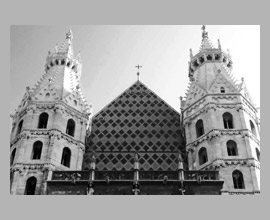
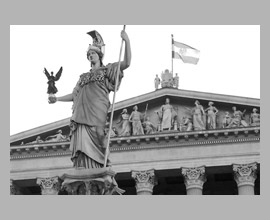  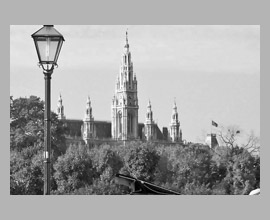  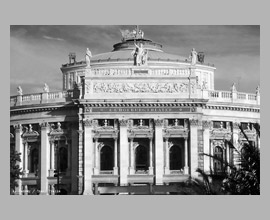  |
| |
|



